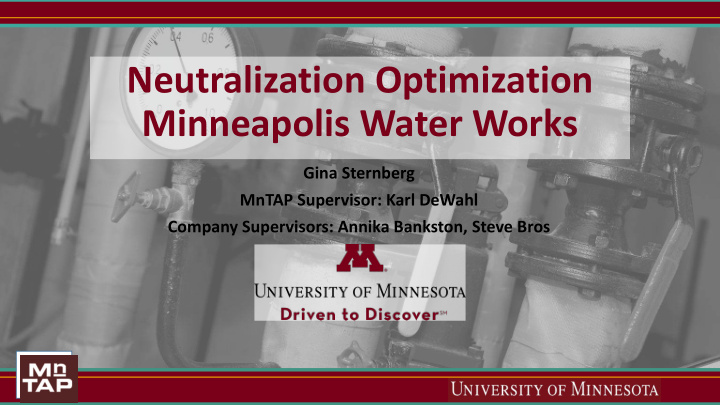



Neutralization Optimization Minneapolis Water Works Gina Sternberg MnTAP Supervisor: Karl DeWahl Company Supervisors: Annika Bankston, Steve Bros
Facility Background • Minneapolis Water provides tap water to Minneapolis and surrounding communities • Produces ~57 million gallons of water per day • Columbia Heights Membrane Plant • Ultrafiltration to remove impurities • Uses hollow fiber membranes
Project Background: Backwashes • Backwashes clean filters • 2 types of chemically enhanced backwashes (CEB) • CEB1: Sodium hypochlorite (bleach) • Sterilizes filter membranes • CEB2: Sodium bisulfite (SBS) and hydrochloric acid (HCl) • Removes fouling, particularly ferric chloride coagulant
Project Background: Neutralization • Chemical backwashes produce waste • Neutralization process: • Completely automated • Waste is sent to neutralization tank after backwash • Raw chemicals added to neutralize harmful reactions • Neutralized waste eventually added back in Mississippi River • Limits: • pH = 5.4-8.8 • ORP = 200-500 mV
Motivations for Change Annual Neutralization Chemical Use • $30,000 a year on neutralization (thousands of gallons) chemicals 18 chemical use (thousand gal) 16 • More neutralization chemicals 14 means more salts in the water 12 10 • Salts a concern, though discharge is 8 within permit 6 4 2 • 40,000 lbs Na+ per year added to 0 water from neut chems NaOH SBS Bleach
Project Overview • Goal: to Reduce Raw Chemicals Used in Neutralization • Areas of interest: • Major: • Self-neutralization – complete • Minor: • Tank mixing – complete • Sources of variability in neutralization – complete • Re-examine ORP limits – progress, incomplete https://www.brandonhall.com/totaltech/images/tt-overview-icon-1.png
Self-Neutralization • CEB2 (sodium bisulfite and HCl) always followed by CEB1 (bleach) • Currently, each wash is neutralized separately • Self-Neutralization • Add CEB2 and CEB1 together to partially neutralize before adding raw chemicals
Current Method: SBS NaOH CEB1 (bleach) Neutralized Waste Neutralization Tank “A” Neutralized Waste Neutralization CEB2 (SBS) Tank “B ” SBS Bleach NaOH
Self-Neutralization: SBS NaOH CEB2 (SBS) Neutralization Neutralized Waste CEB1 (Bleach) Tank “A ”
Findings Annual Chemical Use (thousands of gallons) • Full scale tests succeeded 20 chemical use (thousand gal) • Reduces raw chemical demand 15 • Requires no new equipment • Requires a self-neutralization routine 10 to be programmed 5 • Around 1,500 self-neutralizations per year possible 0 NaOH SBS Bleach • Savings: $12,000 a year Currently Used Used with Self-Neut
Findings: Summary Waste reduction Change Type Waste reduced Implementation Cost savings Payback Status option (per year) cost (per year) period 34,000 lbs SBS Self- Procedure 80,000 lbs Bleach $2,200 $12,000 2.2 months Planned 2018 Neutralization change 26,000 lbs NaOH
Tank Mixing • Mixing a concern with self-neutralization • Two batches at once = larger volume to mix Tank Inlet (not part of mixing) Outlet Intake
Findings • Mixing appears adequate • Surface visibly disturbed by mixing • Measurements relatively constant as tank empties • Self-neutralization requires more mixing time • ~6 min for pH to stabilize, much longer for ORP • 10 minutes recommended to mix self-neut batch • Recommendation: Perform maintenance on system to ensure no blockages
Findings: Summary Waste reduction Change Type Waste reduced Implementation Cost savings Payback Status option (per year) cost (per year) period 430 lbs SBS Maintenance on Procedure Planned Sept 300 lbs Bleach $800 $90 8.9 years Tank Mixing change 2017 290 lbs NaOH
Sources of Variability • With more consistency, more efficiency is possible • No correlations between initial and final conditions found • Tank Level • Unit distance from neut tank • Starting ORP and pH in tank • Potential source: • Pumps for same chemical calibrated differently • Recommendation: Recalibrate pumps, particularly bleach and NaOH
NaOH Pumps Neutralization Pumps 120 Flow Rate (gal/hr) Pump 1 100 Pump 2 80 60 Pump 3 40 Bleach Pumps 20 250 0 Flow Rate (gal/hr) 200 0 50 100 Pump Stroke 150 SBS Pumps Pump 4 100 80 Flow Rate (gal/hr) Pump 3 50 60 Pump 1 0 40 Pump 2 0 20 40 60 80 20 Pump Stroke Pump 3 0 0 50 100 Pump Stroke
Pump Recalibration Summary Waste reduction Change Type Waste reduced Implementation Cost savings Payback Status option (per year) cost (per year) period Recalibrate Procedure 1 year, 4 Planned late 4,000 lbs NaOH $400 $300 Pumps change months 2017
Summary Table Waste reduction Change Type Waste reduced Implementation Cost savings Payback Status option (per year) cost (per year) period 34,000 lbs SBS Self- Procedure 80,000 lbs Bleach $2,200 $12,000 2.2 months Planned 2018 Neutralization change 26,000 lbs NaOH Recalibrate Procedure 1 year, 4 Planned late 4,000 lbs NaOH $400 $300 Pumps change months 2017 430 lbs SBS Maintenance on Procedure Planned Sept 300 lbs Bleach $800 $90 8.9 years Tank Mixing change 2017 290 lbs NaOH
Future Work • Continue investigating ORP • Determine new limits? • Changes in ORP from exposure to air? • Follow-up on pump recalibration
Personal Benefits • Balancing independent work vs asking for help • Planning steps toward a complex goal • Designing experiments • Learning to get the information I need from the data I have
Questions?
Recommend
More recommend